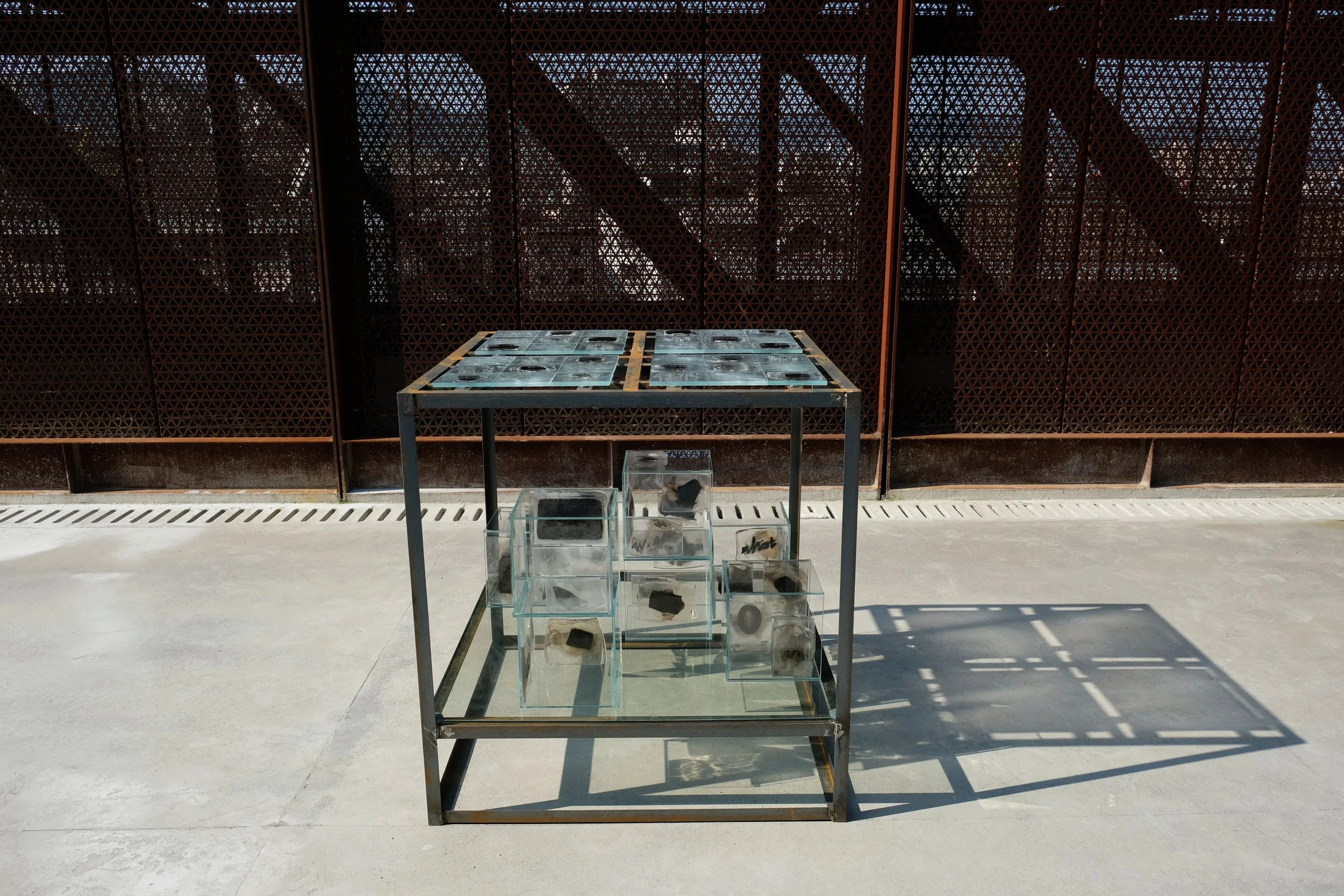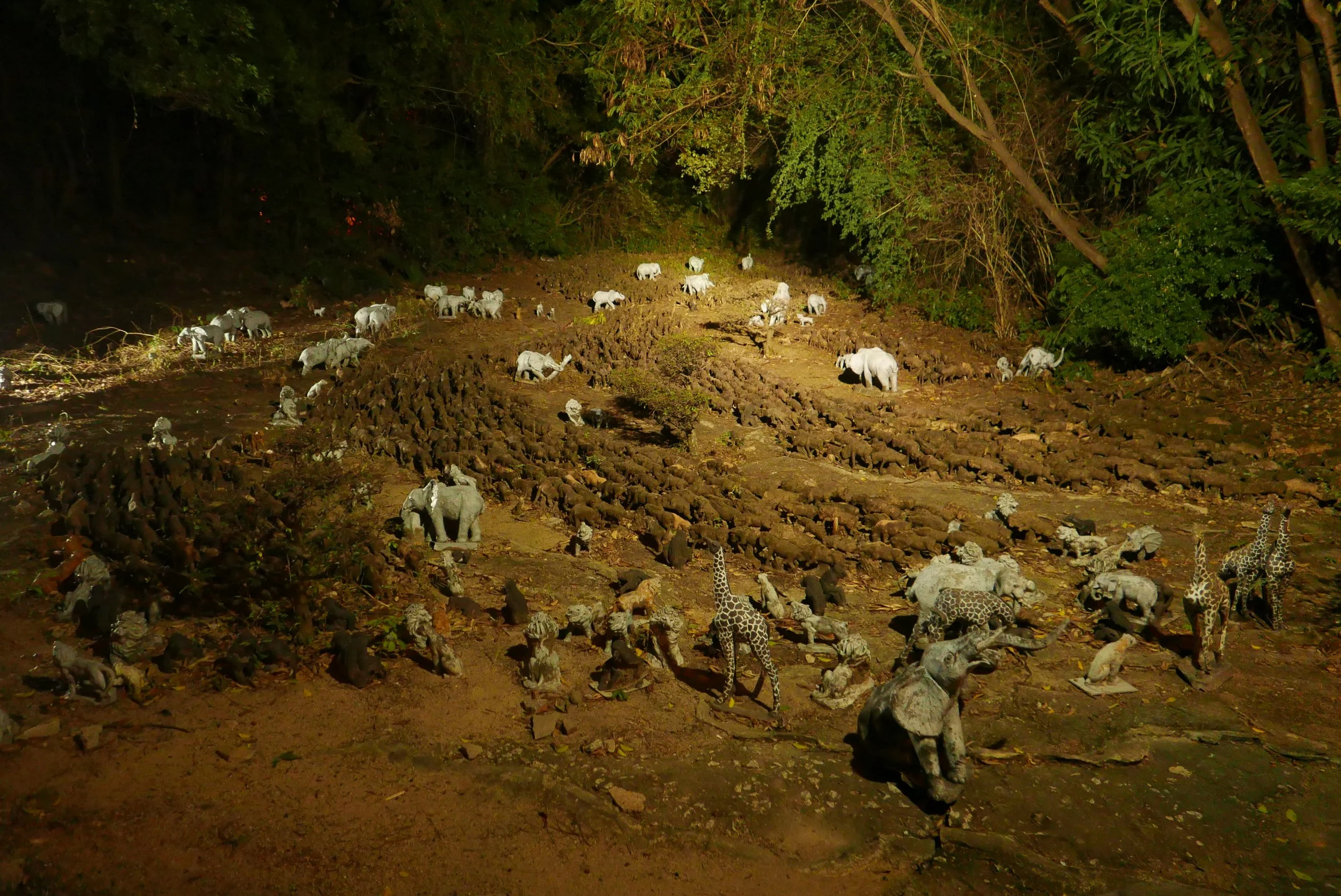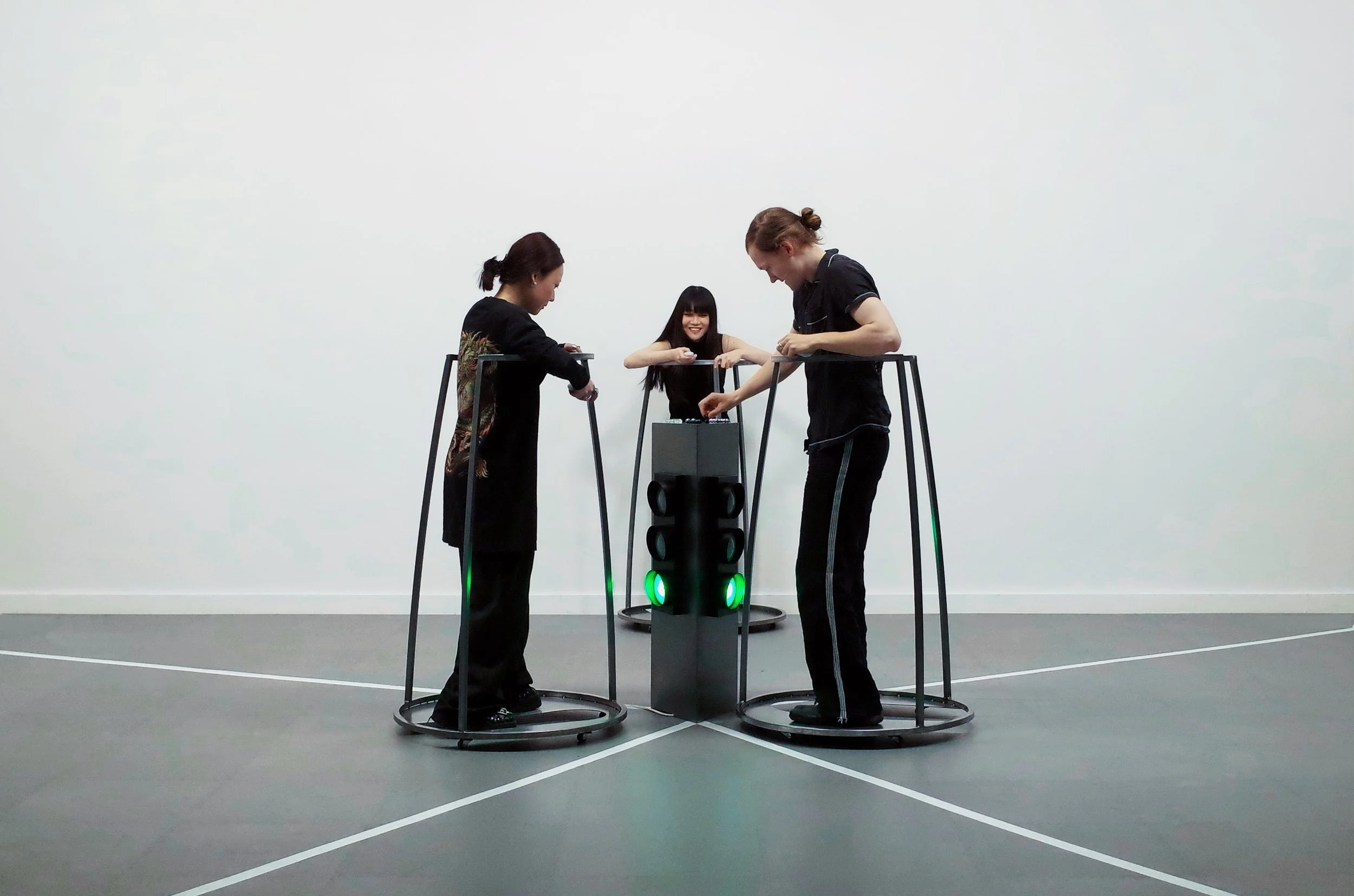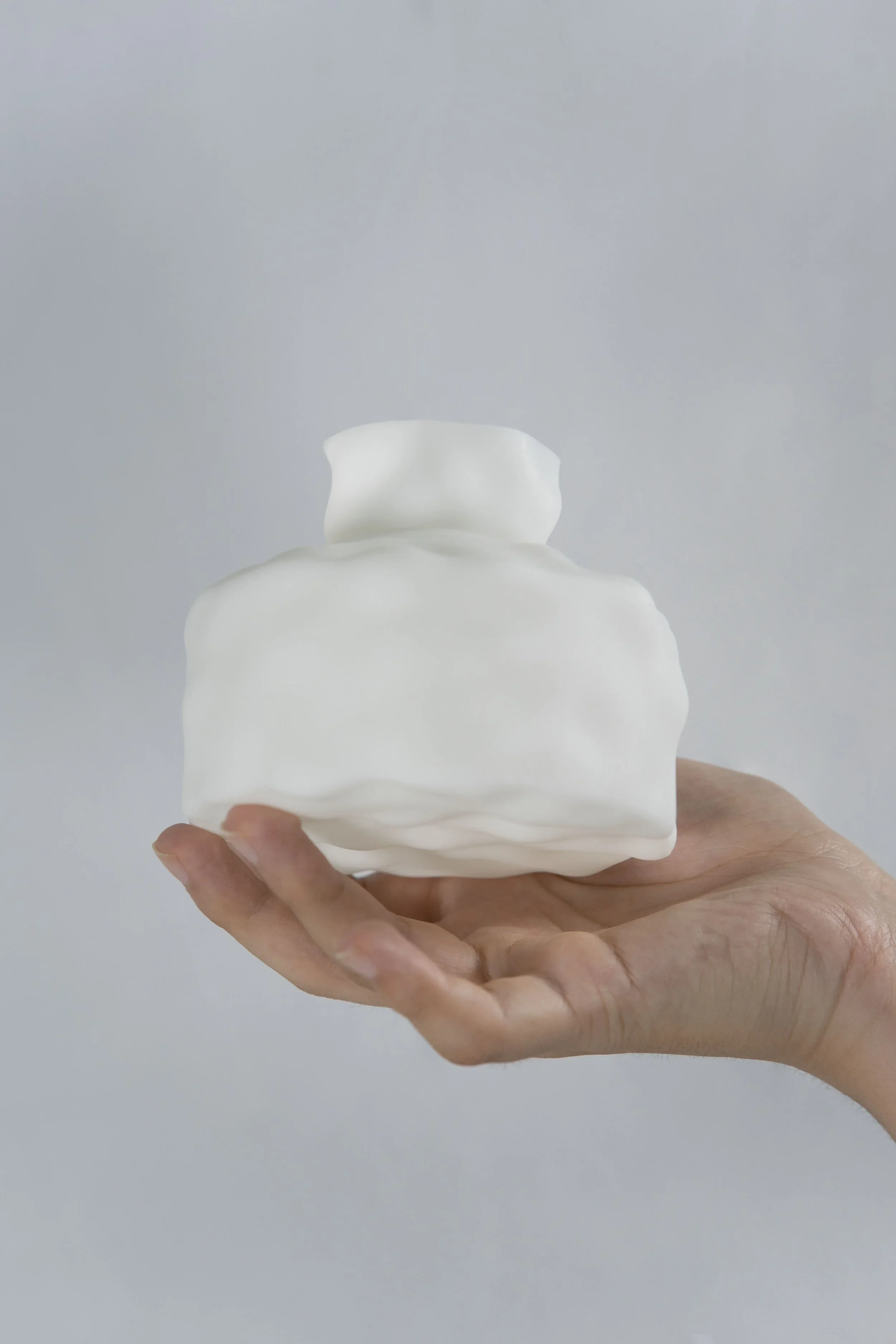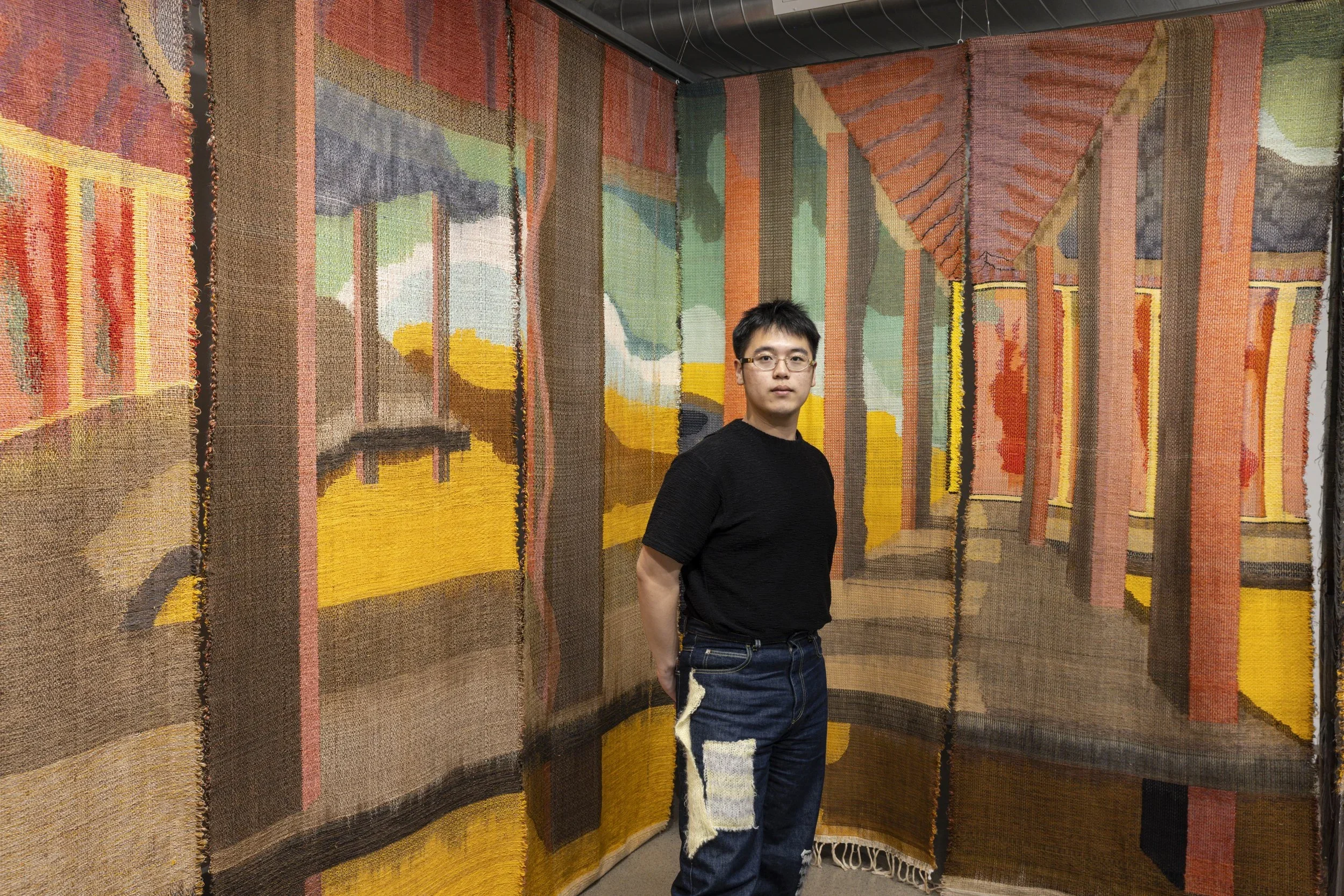10 Questions with Yiqing Lei
Yiqing Lei (b. 1999, Shenzhen, China) is a nomadic artist currently landed in Shenzhen. They hold a BFA from the Rhode Island School of Design in the U.S. and an MA from the Royal College of Art in London. Themes of instability and resilience are imprinted in their formative years. Intention, labour and wandering are important to their practice. Yiqing’s practice involves the eradication and reimagining of past roots and being. They articulate words, sculptures, photos, and actions to create a symbiotic total, which is often obsessed with the ephemera, fragmented, atmospheric landscape.
Yiqing Lei - Portrait
ARTIST STATEMENT
“I live in multiple temporal spaces, drawn to the sentimentality of places, cities, landscapes, plazas, and hotels. My practice is rooted in a constant state of flux, where loss and fragmentation become defining elements of my work. Exile and wandering shape my existence,as I move through, float through, and return to places that echo with the imprints of my past. My art plays with instability and resilience, addressing the eradication and reimagining of my roots and sense of being.
As I wander both within my body and beyond, the landscapes I encounter, seemingly familiar, tangle together, forming rivers and paths that cross time and memory. These paths lead me to my earliest impressions, to the traces that are imprinted in my body, even in the darkest spaces. In leaving my hometown, I left behind shadows that linger, growing and shifting like bubbles that enclose me in a dream-like state. These shadows persist, polishing the stones of my mind, bringing forth new forms, new landscapes, and new cultures that shape my vision.
In response to this constant movement, I integrate words, objects, drawings, photos, and actions into symbiotic containers that create portals for wandering souls. These portals exist as spaces of refuge, tension, and transformation, reflecting the in-between spaces of my own journey and inviting others to find their own places to be.”
— Yiqing Lei
Come as you are, as you were, 2024. Wood, handmade paper, satin photo paper, rice paper, tracing paper, string, nails, tape, wood dust, 60 × 79.5 inch, size variant. © Yiqing Lei
INTERVIEW
Please introduce yourself to our readers. Who are you, and how would you describe yourself as an artist?
I was born in 1999 and grew up in Shenzhen until the age of eighteen when I left China to pursue my undergraduate studies in the United States, followed by a postgraduate degree in the United Kingdom. What I experienced abroad was something my younger self could never have imagined, drifting across foreign lands, moving from place to place, andencountering vastly different cultures. I found myself making art while in a state of perpetual wandering. Throughout this long journey, I've constantly reflected on how my artistic practice connects to my Asian history and how I might articulate a narrative of my own history. Yet, when I returned to China this year, I was met with an overwhelming and unexpected pain. It felt like standing before a mirror turned inside out, suddenly, I was no longer the observer, but the one being observed. I had become the subject of my own gaze.
Your work often reflects themes of exile, wandering, and transformation. How have your personal experiences shaped the way you approach art-making today?
The path of my artistic practice began with "aphasia." I don't know why, but speaking, writing, and verbal expression have always been the parts I long for the most, and also the parts I lack the most. I went through a very, very long period of aphasia. Many times, when my words tried to reach my tongue, my tongue would twist together, stiff with stuttering. This issue is related to early trauma in my life, and also to the development of my brain. Later on, I became afraid of writing and public speaking. However, where I lack depth, I also possess great strength. Non-verbal communication and bodily expression are my strengths.
I am unable to use existing systems of language to express the feelings, memories, and cultural positions I've experienced. This state of aphasia bears a striking resemblance to the theme of exile. In a way, my language left me. I cannot fully enter the language systems constructed by dominant structures, nor can I use those systems to articulate my origins.
The concept of "wandering" comes from my experience of growing up between the cracks of two cultures. My grandfather was a Chinese realist painter; he painted landscapes, oceans, and the revolutionary history of communism. What I studied in the U.S. was Western-centered contemporary art history and leftist political theory. Wandering refers to a turbulent, unsettled experience, a state of being in rupture. It begins with growing in the fissures of reality, neither falling into the logic of sovereignty, order, and law, nor trying to be recognized or redeemed. Wandering is a way of being that refuses settlement. It also relates to cultural migration, population displacement, the alienated relationship between individuals and their surroundings, and the concept of wildness. "Transformation" is about turning a kind of invisible expansion, an energy that cannot be articulated in words, into a form that can be seen and felt. What I mean by "transformation" is the search for roots. It is about using an internal and acknowledged self-structure to rename, reorganize, and reconstruct those root systems that belong to me but were once hidden.
From aphasia to wandering and then to the search for roots, for me, this is not a linear process but a spiralling return. I am constantly moving through, looking back, and repairing within these states, and in this ongoing process, I have gradually built an artistic language that is my own.
Hollow Woman 空心女人, 2022, MDF, alternative photo processes, wood glue, string, rod, 42 x 48 x 3 inch © Yiqing Lei
Hollow Woman 空心女人, 2022, MDF, alternative photo processes, wood glue, string, rod, 42 x 48 x 3 inch © Yiqing Lei
In your statement, you describe your practice as existing in a constant state of flux. What does that fluidity look like in your daily creative process?
Once I stopped identifying myself with a single medium, I began to realize that the creative process itself is inherently fluid. In my daily practice, this means that I allow materials, gestures, and ideas to lead the way. Rather than following a fixed method, I let each day unfold according to what I feel drawn to, writing, photographing, carving, assembling, etc. This flexibility allows intuition to take the lead. Some days, I might begin with a dream, and other times, I work with physical objects.
Your use of diverse mediums, sculpture, photography, writing, and performance, forms what you call a "symbiotic total." How do you decide which medium best suits a particular concept or moment?
I see each material as carrying its own language, like musical notation. Once you start to understand the syntax of a material, a specific visual rhythm begins to emerge. That rhythm, in turn, leads me toward other forms: a sculpture might give rise to a photograph, which then leads to a written reflection or a performative gesture. My piece Hollow Woman 空心女人 embodies this: I transformed the lines and shapes from an oil painting into physical wooden contours, then layered antique photographic processes onto the wood, blurring and clarifying the image through shifts in medium. Each different medium forms connective tissue with each other through the making process. The concept unfolds based on the process.
Performing Landscape, 2023, Epson Matt paper (Books), 120cm x 190cm. © Yiqing Lei
Having lived and studied across continents, from Shenzhen to the U.S. and the UK, how has this nomadic journey influenced the way you perceive and construct "place" in your work?
I perceive "place" as an intimate constellation of daily routines, objects, and sensorial memory. My environment keeps changing, but I hold onto the bed I sleep in, the streets I repeatedly walk, like the once-exotic roads of Olneyville that slowly became familiar, and the textures of the things I carry with me through each relocation. Place, for me, becomes something metaphysical. It is both shifting and persistent, shaped by bodily movement and the quiet accumulation of everyday habit.
It resonates with what Marc Augé calls a "non-place", a transient space detached from identity and history. I construct places through acts of collecting, arranging, and assembling fragments of experience.
In the earlier stages of my practice, I relied on specific, physical locations to create work. For example, the two site-specific installations I made in China during the pandemic, Window of the World and Milk Delivery, were conceived based on my close observations of their respective sites. In Window of the World, I noticed how the miniature architectural replicas inside the theme park created a striking visual contrast with the rapidly developing skyline just outside the park. Years ago, there was a photo of my mother sitting near the Arc de Triomphe fountain inside the park. Back then, there were no high-rise buildings behind her. But when I revisited the same spot to find that exact angle, the backdrop had transformed into a dense forest of skyscrapers.
That thin membrane between the park's unchanging miniature world and the ever-evolving city outside fascinated me. I wanted to extract the mini-sculptures from the park and relocate them into the actual urban landscape, so they could truly exist in the flow of the city's transformation and, more importantly, reveal the historical weight they silently carry.
I bring this spatial and site-sensitive awareness into all of my works. In many ways, I resist the idea that my work should only exist within gallery walls or formal art spaces. I want my work to live independently in any space, or to form a meaningful relationship with the site it inhabits.
Your practice often combines both physical materials and more intangible elements like emotion or atmosphere. How do you balance the visible and invisible in your work?
My work engages with both the tangible and the intangible. From 2019 to 2020, my practice focused on performance-based installations. Since 2021, I've shifted toward smaller-scale, accumulative processes, starting from fleeting inspirations that slowly build into layered forms. This transition reflects a deeper evolution in my creative approach: moving away from a search for singular meaning or formal certainty and toward an embrace of multiplicity, fragmentation, and open-endedness.
The tangible in my work is what can be seen, touched, or held, it lives in materials, surfaces, and forms. The intangible, by contrast, is what unfolds through experience: it must be activated through presence, attention, and time. It is emotional, atmospheric, and often slips between languages. When you engage with my work, you might touch the wood or glass, but what you truly encounter is something else, something hovering between memory, sensation, and the unspeakable.
The intangible is exactly what I refer to in my artist statement: I integrate words, objects, drawings, photos, and actions as a symbiotic total to create containers, portals for wandering souls, and places to be. The emotions you feel from the work, the kind of inspiration or subtle resonance that reaches you through the encounter, that is the intangible. The ultimate goal of my practice is to touch that intangible realm: to speak in a language of colour, rhythm, and embodied experience that I cannot otherwise articulate in words.
I imagine it placed in a bright, open room 我想象它置身于一间敞亮的房间”, 2025, Glass, nine years compulsory education textbook, steel, 120cm x 120cm x 120cm © Yiqing Lei
I imagine it placed in a bright, open room 我想象它置身于一间敞亮的房间”, 2025, Glass, nine years compulsory education textbook, steel, 120cm x 120cm x 120cm © Yiqing Lei
You mention the idea of "portals" in your artist statement as spaces for wandering souls. Can you share a recent work that functioned as one of these portals and what it revealed to you or others?
Photography, for me, is both a window and a form of escape. It is a portal in itself. Many of my works take place in transient and ephemeral settings, cities, private rooms, temporary environments, or even within the body itself. Photography becomes the tool I use to record these fleeting moments of existence. It is an entry point into the spacetime of these works, almost like a time machine. Personally, I often experience the world through a sense of darkness, of prolonged obscurity, of waiting. After long periods of drifting, I slowly begin to grasp threads that unfurl and stretch, threads that seem to connect me to a distant, unknown presence. What lies before us is the "now"; but as we pull on these threads, the other end reveals "memory", a faraway shore slowly slipping from our grasp. A portal is a journey, a bridge, a dream. To travel through one is to break free from the constraints of time and enter another realm. Portals manifest in many different forms throughout my work. In the early stages, they existed as a piece of film. In Time Piece, for instance, the work is placed directly in front of the eye, and through a magnifying glass, one sees the image imprinted on film. It's a fixed clock, yet also a time device that belongs to another dimension.
In Providence, a transparent crystal sphere reflects images that shift depending on the surrounding environment. It is an escape and also a window, a lens through which to observe another place.
In my 2024 work Come as You Are, as you were, I used photography more directly as a portal. I transformed my photographs into three artist books, placing them within the installation. Viewers must crouch down, turn the pages, and physically touch the images and texts; through these gestures, their bodies unknowingly enter the atmosphere of the work.
What are you currently working on, and what directions do you see your work taking in the future?
I recently completed a new body of work. When I returned to China last November, I felt an urgent and almost irrational desire to destroy the things that had long gathered dust in my childhood home. Among them were four boxes of textbooks from my nine years of compulsory education. These objects had lost their function, sitting inert, waiting for a new configuration. I began to wonder if they could be transformed, less through symbolic meaning than through the memory held in their material.
At the Taoxichuan Glass Art Studio, I was given the space to test this question. Using hot slumping and kiln forming, I embedded the textbook covers between sheets of molten glass. The process was violent. Paper, when exposed to fire, burns chaotically. However, in this case, the glass pulled oxygen from the flame, freezing the combustion process midstream.
What resulted was an image of entrapment. A breath suspended in transparency. A trace preserved just before vanishing.
Later, I polished the fragments and assembled them into clear glass structures. These forms are not narrative containers. They are bodiless, offering no fixed identity. They remain open, vacant, waiting. The work's meaning shifts with light, location, and angle.
My practice has always existed between exhibition and disappearance. Some works resist traditional display formats and exist in states of flux. Photography allows me to engage with the intangible. I just concluded a residency in Jingdezhen at the Taoxichuan Glass Studio, and I'll continue working with various materials and processes, including photography. I'm also developing a self-published artist book that brings together my images and writing in printed form.
Window of the World, 2020, Found objects, wood board, wheels, string, glue, 31 x 80 x 21 inch. The Window of the World theme park, Shenzhen, China © Yiqing Lei
Lastly, as someone constantly moving, where do you see yourself and your work next, and where do you think or hope life will take you?
I hope to continue making work wherever I am. The place itself matters less than finding a sustainable way to create. I want my practice to grow alongside me, to shift with age, experience, and the shape of life at any given moment. When I'm drifting, the work reflects that drift. When I find stability, the work may settle too. What anchors it all is a commitment to honesty. I create from what I genuinely feel.
Artist’s Talk
Al-Tiba9 Interviews is a curated promotional platform that offers artists the opportunity to articulate their vision and engage with our diverse international readership through insightful, published dialogues. Conducted by Mohamed Benhadj, founder and curator of Al-Tiba9, these interviews spotlight the artists’ creative journeys and introduce their work to the global contemporary art scene.
Through our extensive network of museums, galleries, art professionals, collectors, and art enthusiasts worldwide, Al-Tiba9 Interviews provides a meaningful stage for artists to expand their reach and strengthen their presence in the international art discourse.
